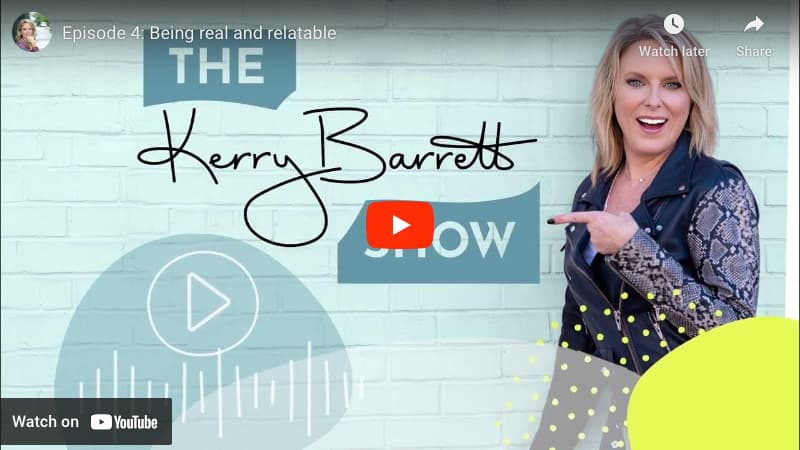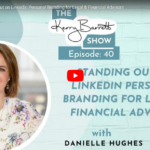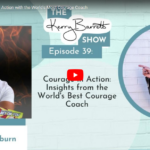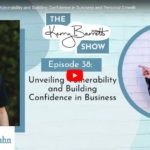
In this episode, I talk about what it is that makes somebody authentic, real, the Relatability Index and basically why and how relatability is important in leadership, business, communication and getting buy-in from your employees or your content.
Transcript
Kerry Barrett: Welcome to the show and thank you for listening.
During this episode, we are going to take a bit of proprietary research that my company has done and apply it to the way that you show up on camera. Now, the research is something that I have trademarked; it’s called the relatability index. And basically, the research took a look at why and how relatability was important in leadership, in business, in communication, and in getting buy-in from your employees or your content. It also looked at what those key characteristics of relatability are, what they mean, how they show up, and then, of course, how you can improve upon them.
15:11:47 So we’re going to get to that, but I first want to talk about what it is that makes somebody authentic, real, and all that other stuff on video. And, to be honest with you, a lot of those are buzzwords that get thrown around and don’t mean much anymore. We have a general idea of what they mean, but we all have our own take on them and how we apply them. And that’s fine. But for the sake of this conversation, I want to be clear about what I mean when I say authenticity, and I say being real. Because there is a difference between communicating on a camera or through a lens. There is a difference between communicating on a stage in a stadium in front of tons of people in a conference room to a team of eight or with one person who you know really, really well who’s sitting, you know, three feet away from you.
15:13:31 And so being on camera speaking on video, whether you are creating social media video, or you are creating a video sales letter, or landing page video, or you are using video as part of your sales process, or a live stream, a podcast, or you’re appearing on your local or national TV station, you have to recognize that those moments where you are on a camera, there is a performance element that goes along with it. Now, I often say that and people say, “Oh my gosh, Kerry, what do you mean, there’s performance? I thought we were supposed to be real. And I thought we were supposed to be authentic.” When I say performance, what I mean by that is, you have to understand the challenges that that lens and the microphone put in front of you. And then you have to accommodate and mitigate those challenges with the way that you deliver. So, for example, you probably understand at least academically, the difference between sitting in a small, quiet and distracting conference room with one person who’s sitting at a table, you know, two feet across from you whom you know very, very well. And you’re having a quiet or sort of very conversational flow back and forth. That versus, let’s say, standing on a stage in a crowded stadium with tens of thousands of people around you who don’t know you personally, who are distracted and disconnected, who are all busy looking at their cell phones and aren’t focused on you. Heck, they may not even know you’re on the stage yet.
15:22:34 So the way that you would differ between those two types of conversations, one is very normal and natural, one you’ve got to perform in order to be able to grab and then keep your audience’s attention. Video is very similar. And you’ll hear me say this often, but it does bear repeating. It is scary for people because we want to shut down, we want to get quiet. And there’s a number of reasons for that. And I will dive into them, where the origins of this fear come from in the next episode of this podcast. But being in front of people, whether you’re on a stage or on camera, is terrifying for a lot of people. There is a reason most people hate public speaking, and I was one of them, I get it. It is very, very scary.
15:23:08 And then you take that element of speaking in public, whether it doesn’t matter if it’s live or recorded or whatever it is, and you add the camera component, which introduces an additional unnatural environment. It’s out there on the interwebs, you know, long after I am dead and gone from this earth, that adds an additional level of fear and terror to these two components. And so we have a tendency to get small. All I’m saying when I say you have to understand there’s a performance is that you have to understand their challenges and your delivery if you are doing talking heads. It’s panel events, it’s all that stuff that is talking head video. Your delivery is the thing that has to compel them, that your delivery is the thing that has to engage them, it has to jump through the lens and sort of land on their lap.
15:22:37 Now, that. So as you begin to get more competent, and then you don’t even really need the confidence because you got it down pat. Now that you have that down pat, you can really begin focusing on the audience; that should be part of your strategy. Once you start worrying about what you’re doing with your hands, it is all you’re screwed. And so that skill stuff and the understanding of it needs to go on autopilot. So you really can focus on putting your audience at the forefront. And once you’re able to do that, all of those other fears begin to go away. That’s when you can start reading. Anyway, this does apply to social media video, but it applies in most longer-form content, good content and formats, rather, more so. And the reason is, because there’s usually not as much editing. You’re talking to an audience that may not know you. Ideally, you’re talking to an audience that doesn’t know and social as well, and you’re bringing them into your network.
15:14:05 Now, this study that we did about relatability focused on six sort of key components of what relatability is, and I’m going to run through them for you right now, what they are, and then what they mean, and how you could think about how do you show them in the way that you lean on video on stage on camera when you’re speaking, etc.? And the first one is likability, and it sounds very simple. Yes, obviously, the more people like you, the more that they can relate to you. We have a tendency in business, especially to say that we don’t care if people like us, and perhaps some of us don’t. I do, I would like people to like me because I would like them to want to work with me. And if they don’t like me, they’re not likely to want to work with me. And if they do, we’re likely to not have an enjoyable time together.
15:22:34 So I guess I need them to respect me, but I also want them to enjoy working with me and liking me. So if you’re wondering how likable you are on a camera or on a video, do a recording, do a recording of you doing a sales call or you doing a team meeting, and then show it to somebody who has discretion and is not going to share it with everybody else and ask them, “How likable do I look on this video? Does my team relate to me? I’m on a virtual sales call on Zoom or Google Meets or whatever it is. By the way, using video in sales is a fantastic way to not only bring in clients but also accelerate the sales process and speed up the sales cycle. But ask them to look how likable I am if your videos aren’t having an impact? Maybe this is where you begin?
15:12:00 The second component is honesty. And I’m sure you’ve heard the expression that a brand is not what you say it is, but it’s what the client says that it is. So, how honest are you? And maybe even more importantly, how do you show that honesty when you are on camera on video when you are communicating? Meaning, do you try to cover things up that are not, you know, ideal? Your kid walks into the scene, do you, you know, not acknowledge them? Or nicely move them, you know, aside? Do you pretend to cover it up? Same goes for mistakes that you make. You may be on a stage delivering something and you have a big fumble, or you say a word that you shouldn’t say, it’s happened to me before. I’ve said, she’s my language, Salt Lake city on the air, instead of saying Salt Lake City on the air. And I tried to brush it and hope that nobody heard it. And they did. And then my honesty, my credibility took a little bit of a hit.
15:13:01 So how honest are you? And how do you show it? Vulnerability, I talked about being real and being authentic. Vulnerability is a buzzword absolutely right now as well. And vulnerability doesn’t necessarily mean that you have to spill all of your insecurities and all of your fears. But you can use those things to inspire and to motivate and to talk about challenges that you’ve had. And they do make you more real if you are looking to coach or train somebody or bring a client in. You know, I like to serve the people who I once was, people who are fearful of showing up, don’t know if they can grow their confidence enough, don’t know the skills in the Navy, they don’t even know how to use a video once they have it or they’re on camera abilities. And so I share the fact that I have made some really bad mistakes. And I was terrible and terrified when I first started my news career, but I had to learn. And because of those fears, I came up with a framework that worked really, really well. And now I use that same framework, because I know it works, to train my own clients and walk them through that process as well.
15:13:30 So vulnerability, what does it look like? How do you convey it? Because we all know, you know, you weren’t perfect from the moment that you were born? And what do you do now to inject more vulnerability into the way that you talk to your market, the way that you talk to your followers, the way that you talk to your customers, your team, etc., etc.? The next element, the fourth element is empathy. And the truth is, we do all have empathetic and nurturing tendencies, some of us absolutely 100%, we have them more than others. And we have to be deliberate about showing it. Somewhere along the line, we learned that being empathetic was not something that we should showcase or use at work, we learned that if we were empathetic, our teams were going to take advantage of us or our clients were going to take advantage of us. And so we had to become sort of hard and put that armor on. And the truth of the matter is that empathy does belong at work.
15:22:34 The idea that it doesn’t and does belong in communication specifically, and it does belong on video. The idea that it doesn’t is 100% Wrong. So the key when you are showcasing empathy, and you’re showcasing it on video, as a leader, you’re showcasing it in content, maybe you are somebody who’s training a group who struggles with, I don’t know, are having issues in their self-esteem, something along those lines. Empathy is not in that moment, trying to jump in and fix everything all at once. Or if you’re, you know, talking to an employee on a zoom call, not jumping in and fixing everything all at once unnecessarily like letting them off the hook. But it’s to understand it’s to step inside their story if you will, and have a look around. So my question to you is, how do you show that element when you are on video, creating video on camera, etc.? The next one is pleasure. And I really like this one. It reminds me of my kids.
15:14:08 Pleasure is one of those super high relatability index traits. It’s very overlooked in sales and marketing. It was a podcast that I did earlier with Chris Bogue. And I’ll link it in the show notes, where we talked about the importance of humor in sales and content creation. And pleasure is part of that humor, laughing, seeing something funny, genuinely funny and real brings us pleasure, again, often overlooked in sales and marketing, but a huge component and something that can be created and delivered on video as well. Regardless, again, whether it’s live stream, whether it’s recorded, etc.
15:22:34 So, to take the example of my kids, especially when they were younger, one of the first things that they wanted to do when they met another child is to show one of their new toys or shared toys back and forth between the two of them. It gave them great pleasure to be able to share toys and see somebody else’s toy and have somebody else saying, “Oh my gosh, your toy’s super cool. I really like that. That’s awesome.” So sharing what we like to do as adults is pleasurable as well. And what I mean by that, that sounds a little funky. But stay with me here. What I mean by that is we do that all the time. “Oh my gosh, I have just made this amazing. I don’t know, Stromboli, it’s a new recipe, come over and check it out, have a bite,” or “Oh my gosh, I have these new shoes, they’re amazeballs, come and take a look at them. Do they look good with this dress? Should I wear them tonight?” or “I just redecorated my home office, come take a look at it. I really love the way that it sort of…” All of those things are pleasure and they are shared. And it is a great way to connect with someone on the other side of your social media lens of the camera, etc., etc. We have a real edge in business if we are able to do this.
15:14:05 Now the last one is pain, which is obviously the opposite of pleasure. We shy away when things go wrong. And understanding or making a simple genuine acknowledgement of someone’s pain can go a very long way in buy-in and in leadership and in communication. So for example, you know, I always say that rather than have no comment or have a press release written out by a third party when a company is in trouble or has made a mistake. If you can have the CEO or whomever is in charge of the department, the figurehead, go on a camera and make a genuine acknowledgement of the mistake.
15:12:47 Now, I’m not talking about adding to the liability or anything like that. But we understand what happened here was painful for a lot of people or created a lot of problems and we are genuinely apologetic about that. What comes to mind, as I’m talking about this here, is what’s going on in the airline industry. Pilots are short-staffed, flight attendants are short-staffed, flights are getting canceled. People are being promised vouchers for hotels, they’re standing in three-hour lines of customer service. They’re not being turned, you know they’re being turned away. It was a massive debacle. And yet the only thing I have heard on the news is either a statement that’s written by a third party. Clearly it’s very whitewashed, or it’s the CEO of one of the airlines. And I’m not going to name any of them because my husband is a pilot, but one of the CEOs on the news talking about how they have everything under control. You don’t. So acknowledging pain is another way to be relatable and to get buy-in. And by the way, there is a specific CEO I’m talking about. Not only has the CEO lost the buy-in of their employees, and this CEO has lost the buy-in of their customers as well. So it is not just those who are internal or external to the company, those sorts of statements, although they’re directed to the consumer, they affect the internal morale and trust and credibility and relatability and pain of the employees as well.
15:22:34 So when you think about bringing all of those elements together, you’re putting the audience first, you’re understanding what you need to say. And those emotional elements are the things that help make you make that connection. They’re the things that make you relatable on the relatability index. What comes first, though, is getting their attention; authenticity and realness will always be there. And making mistakes is fine. It doesn’t mean that if you go on a long, rambling, bumbling, mistake-laden diatribe on a recorded video that you don’t go back and fix it. What it does mean is that you can show up and meet your audience where they are. If your audience is in construction, you don’t show up on camera in a three-piece suit, you meet them where they are, communication style, in appearance, and what comes before all of that is the way that you are able to deliver because if you can’t get their attention first, all that other stuff isn’t going to matter because they’re not going to listen. So get their attention, make sure that you’re meeting them where they are, and then connect with them in a real authentic and relatable way using the key characteristics on the relatability index. Thank you for listening to this episode of the Kerry Barrett show and I will see you next time.




